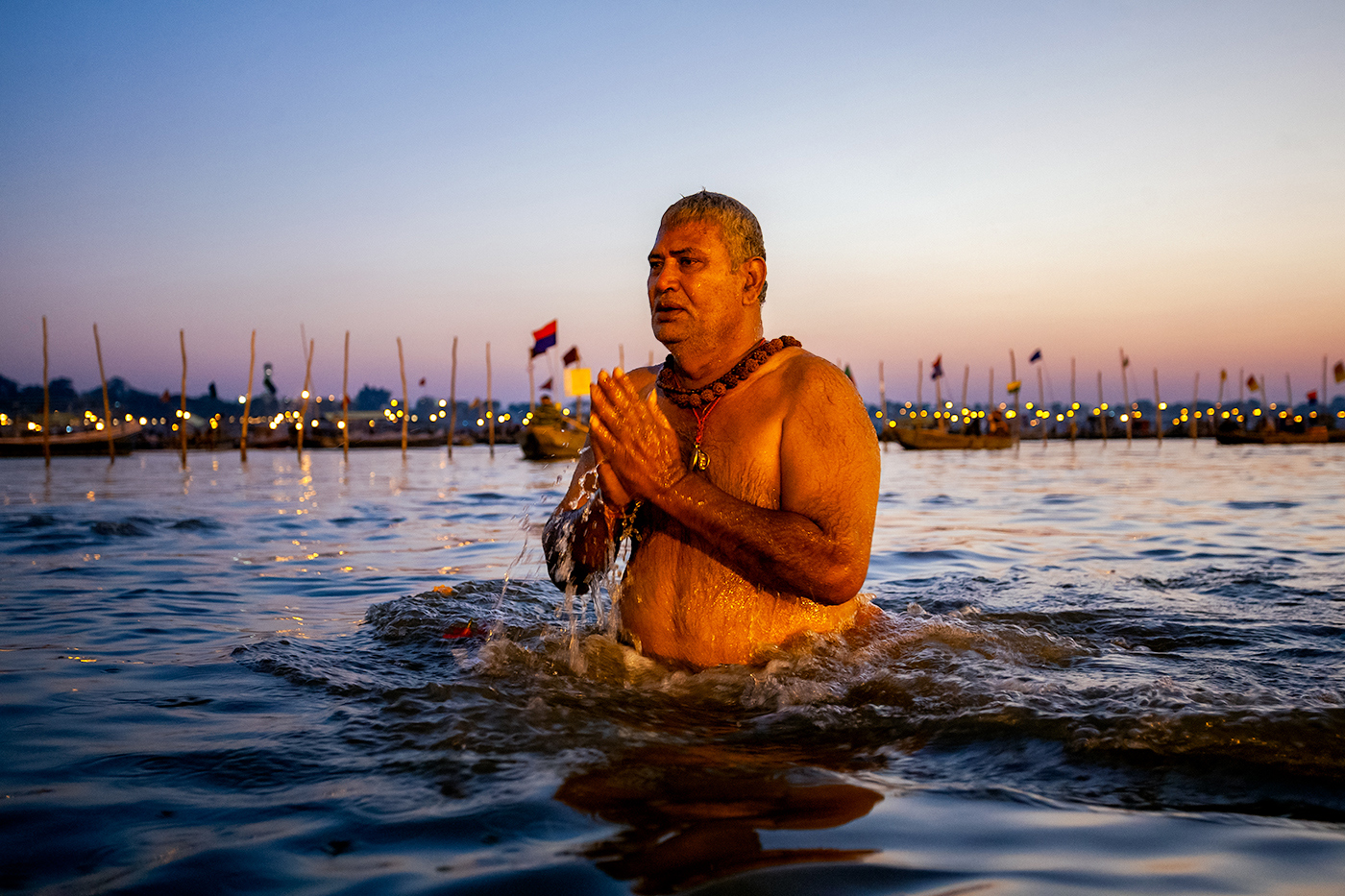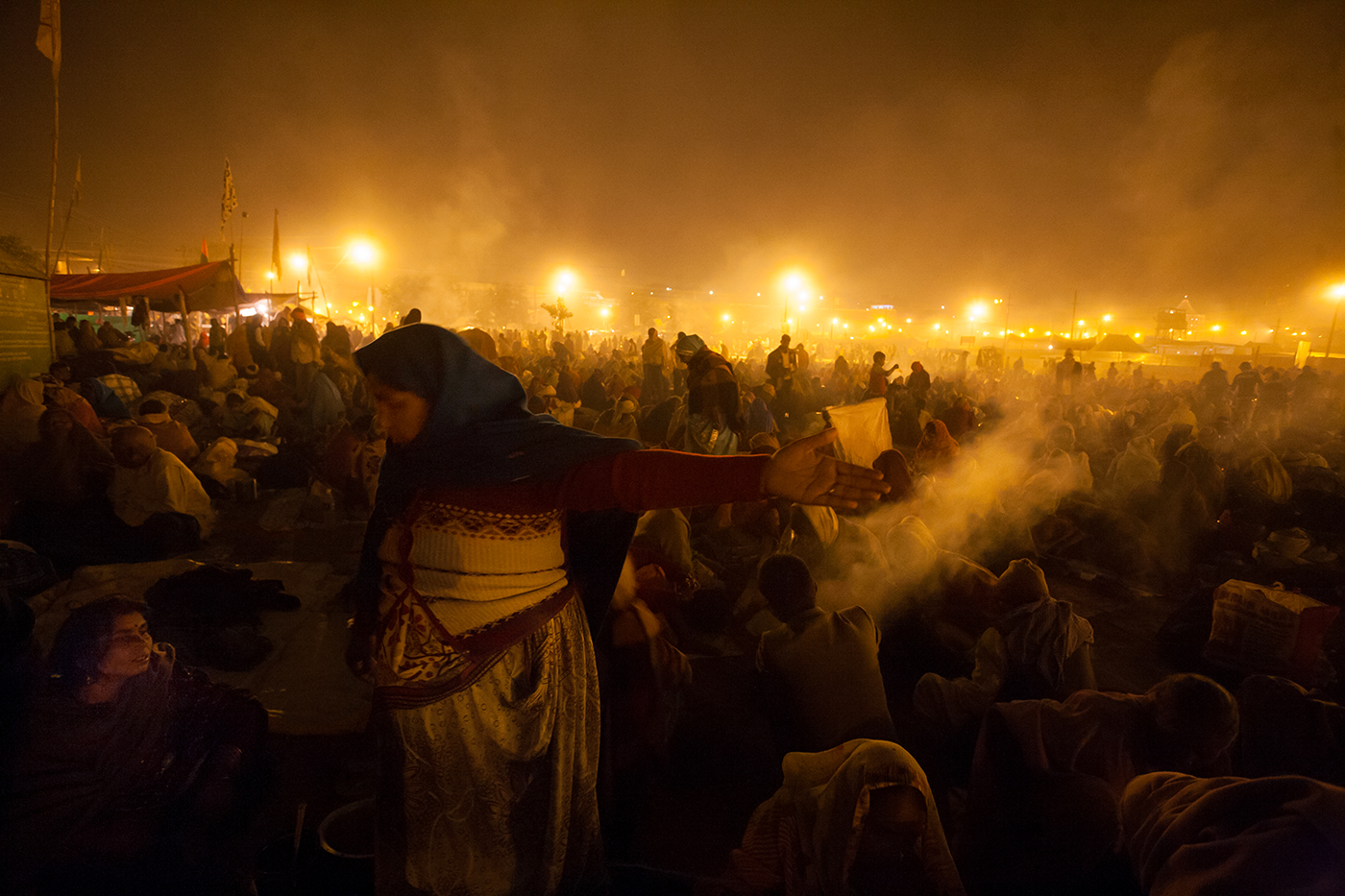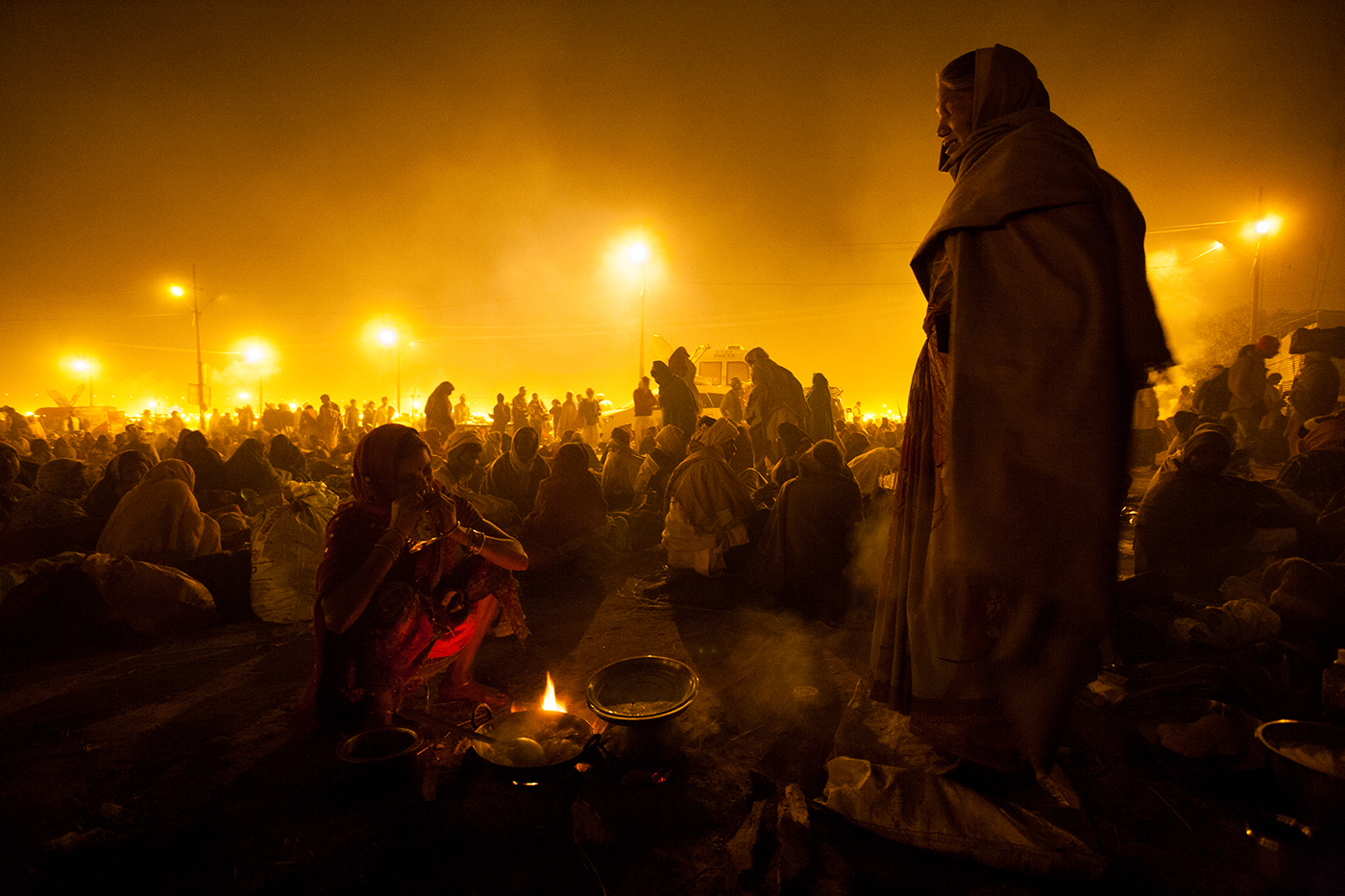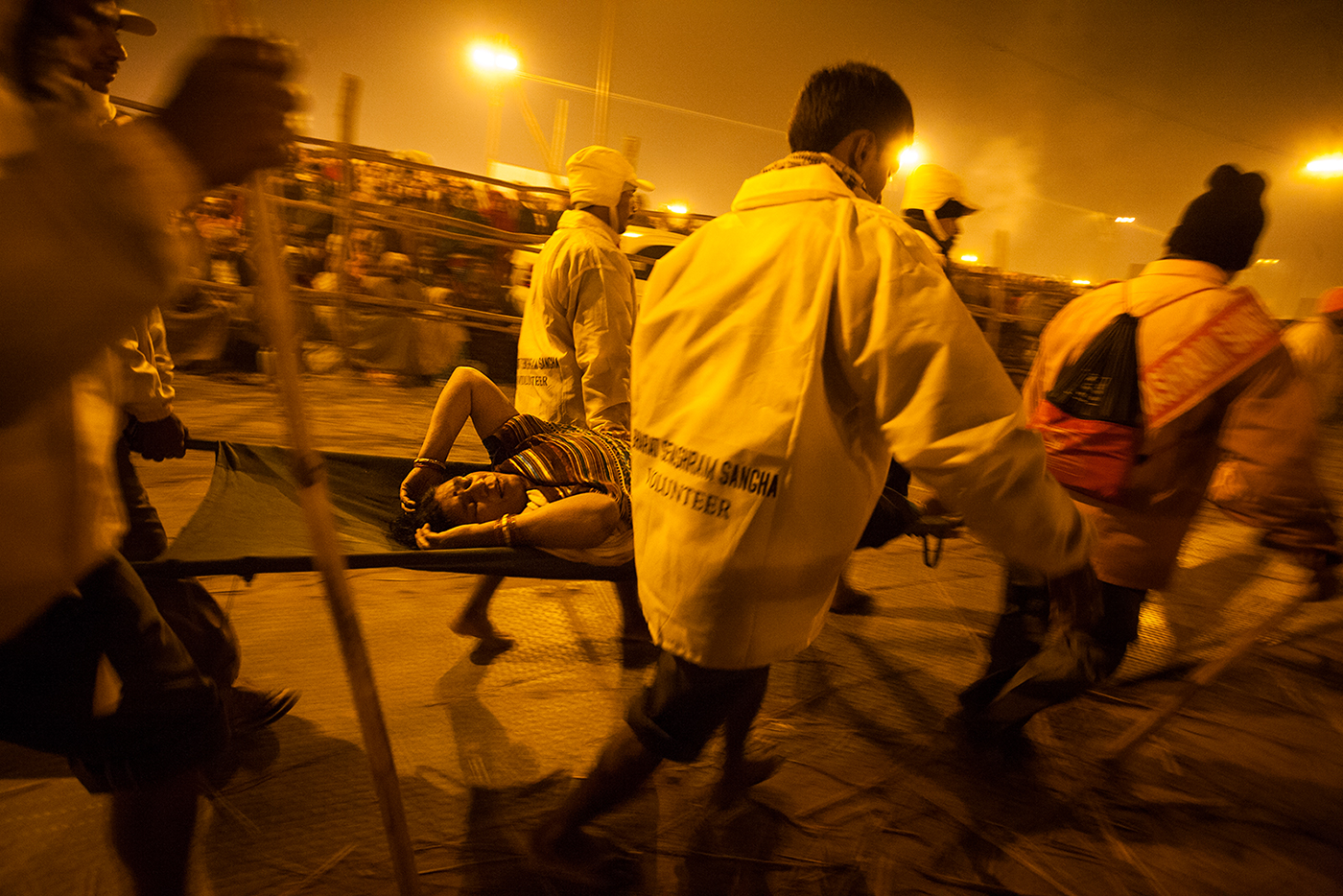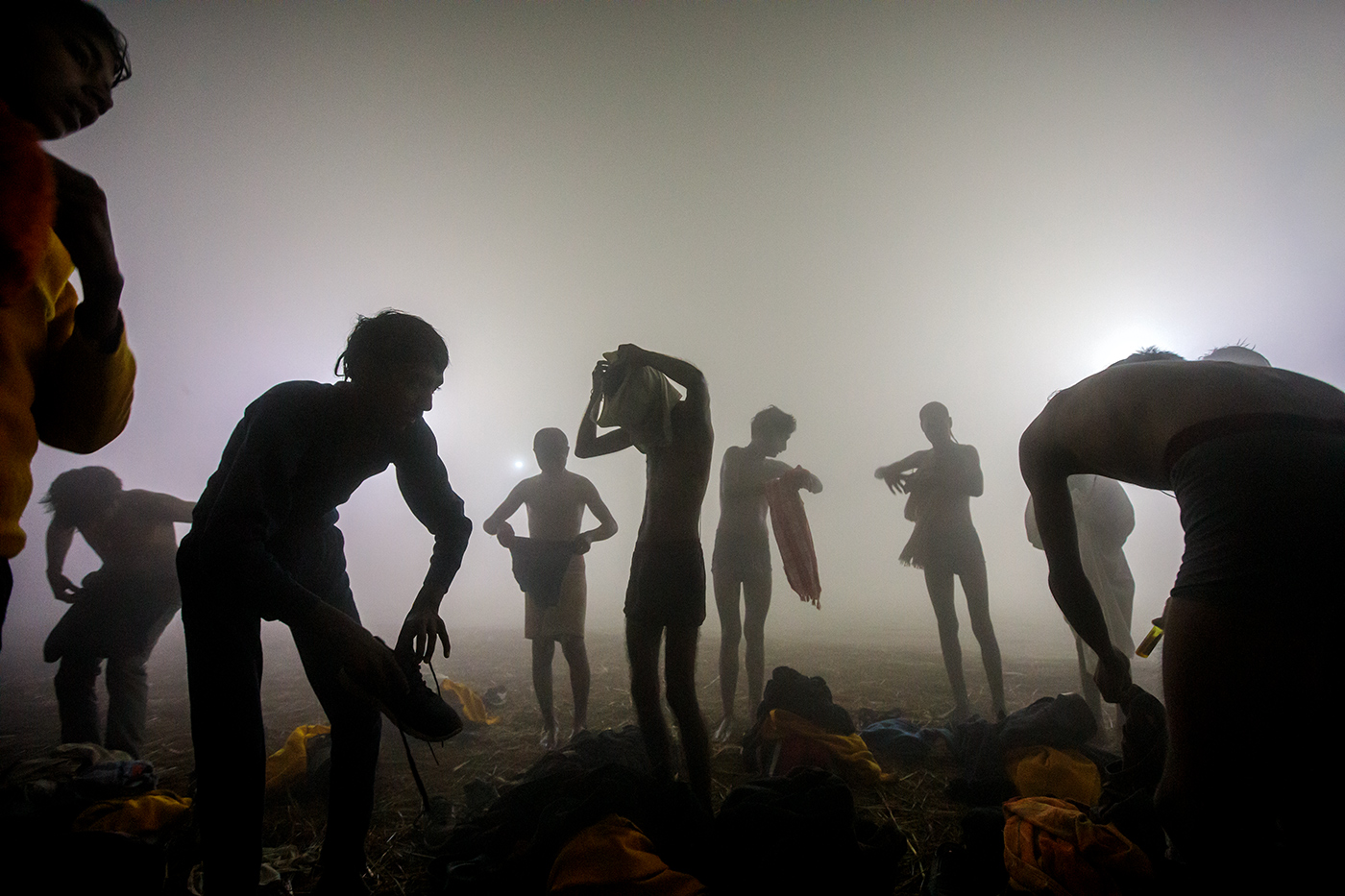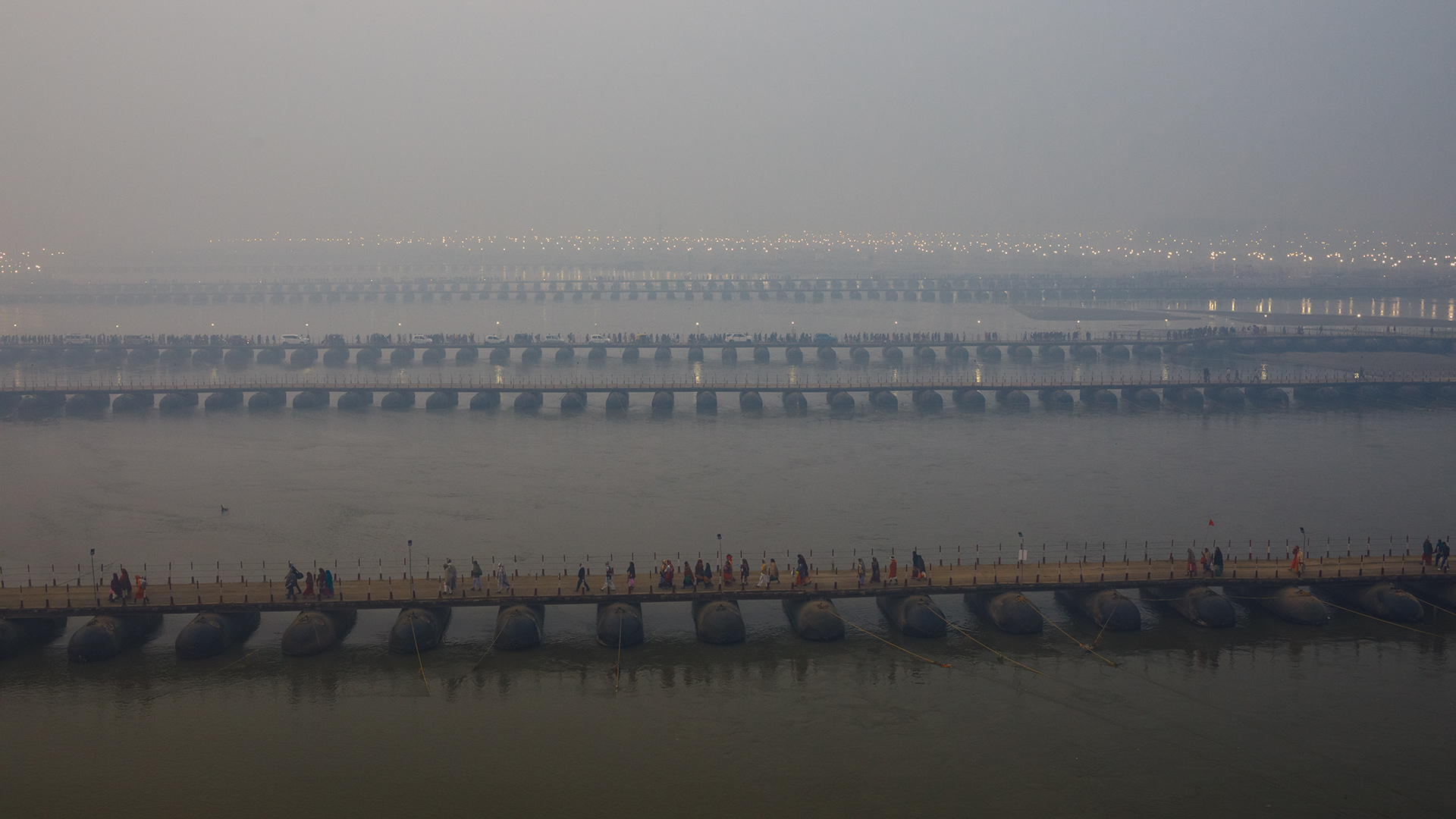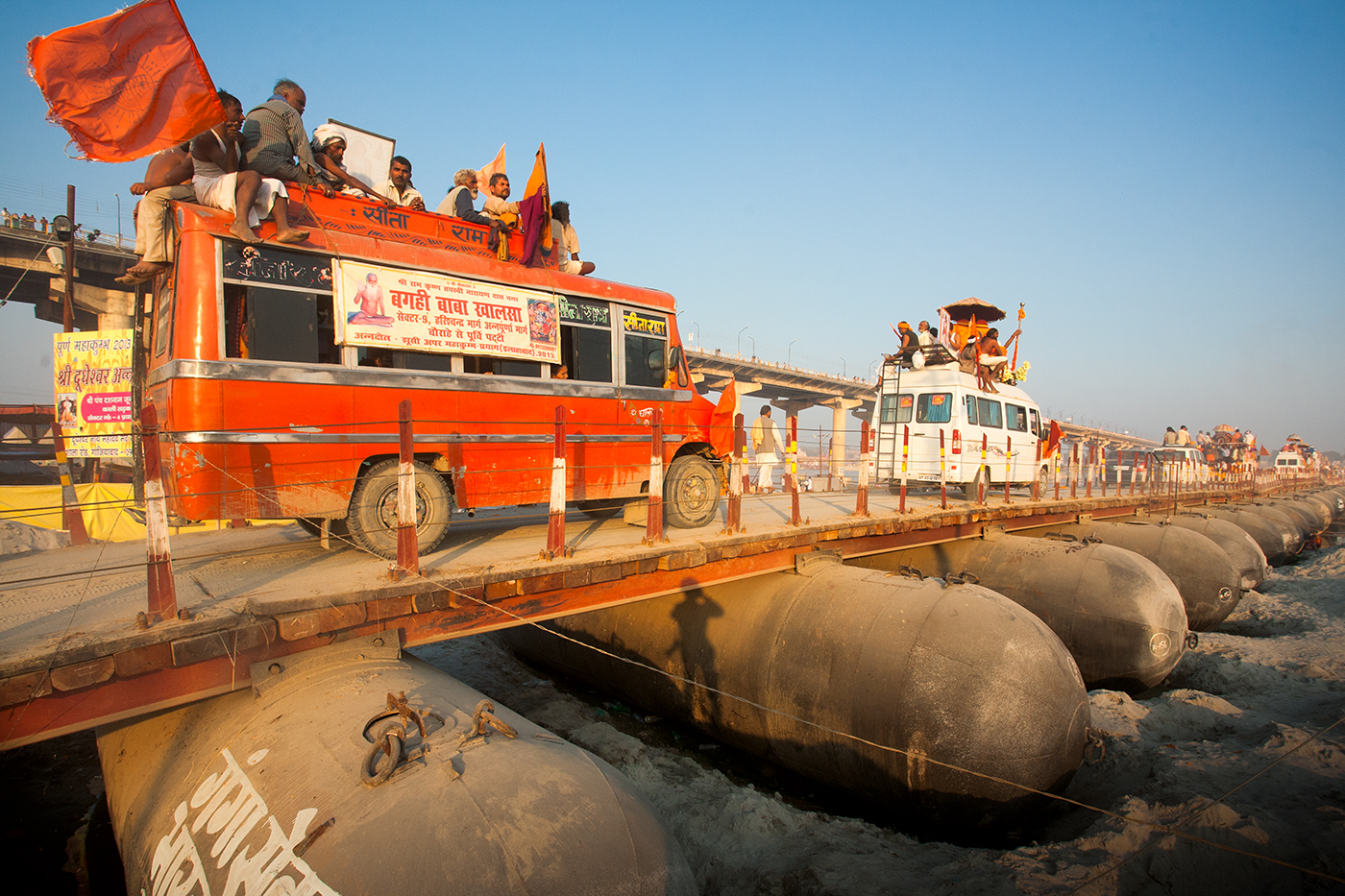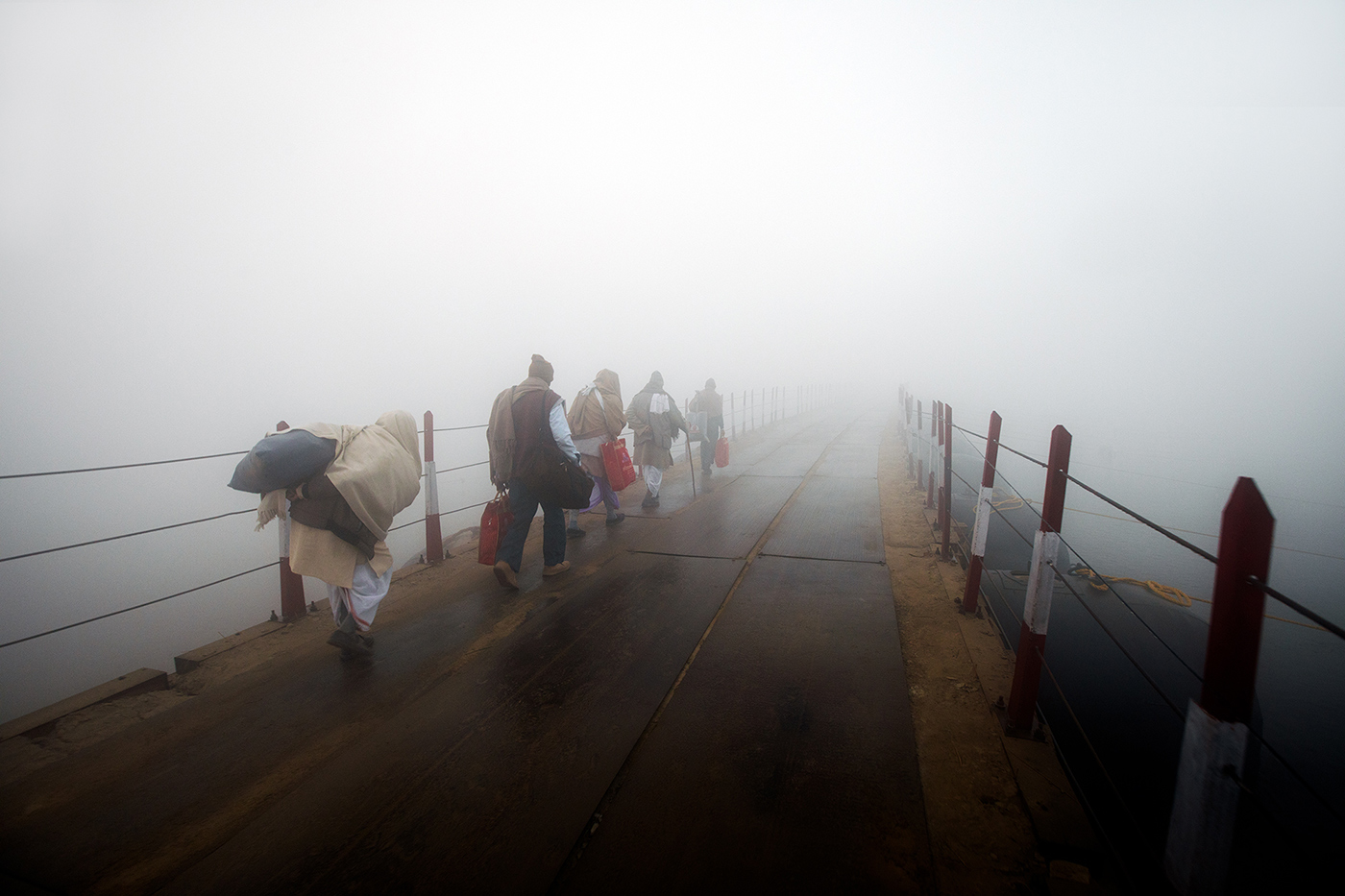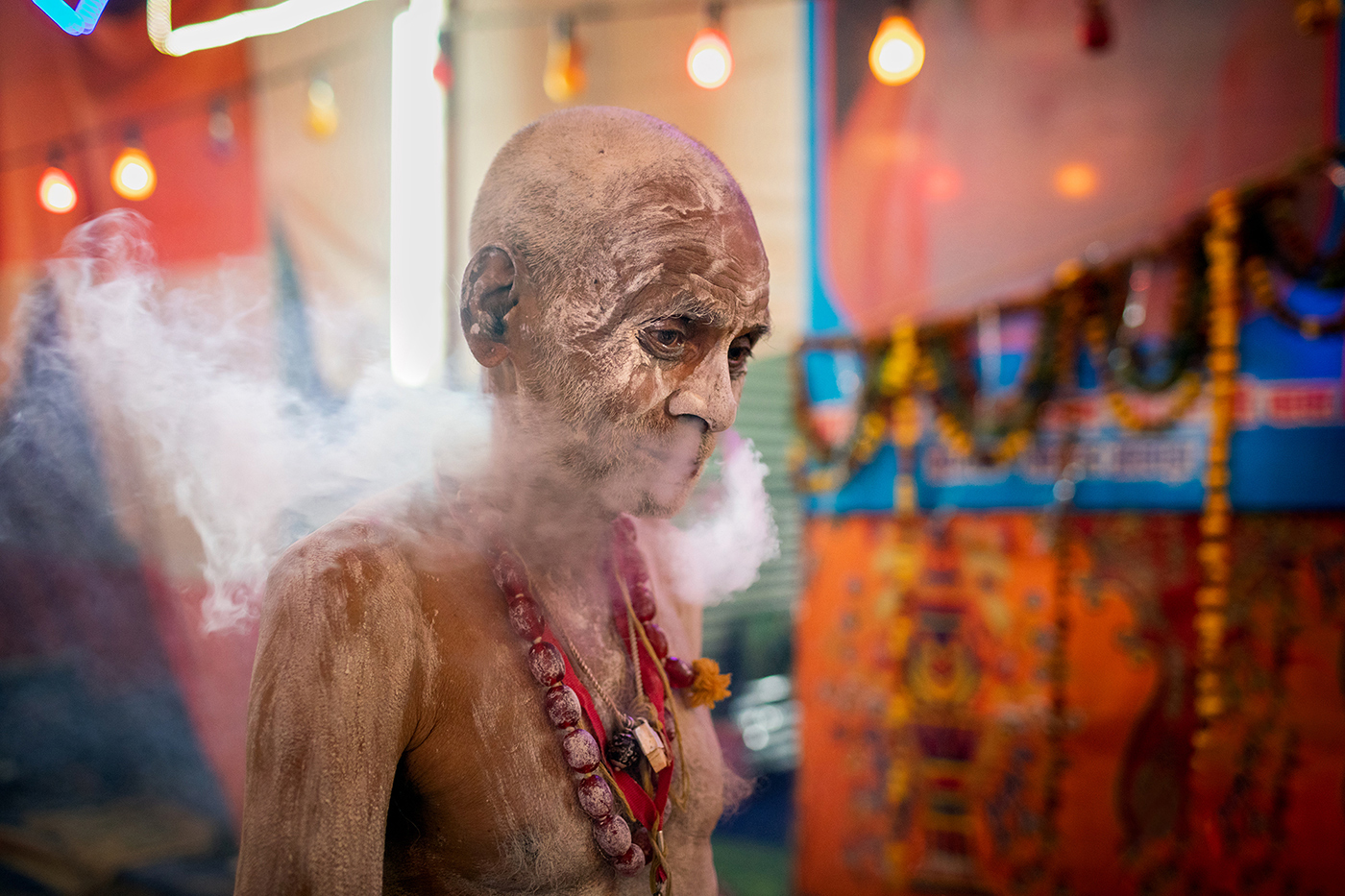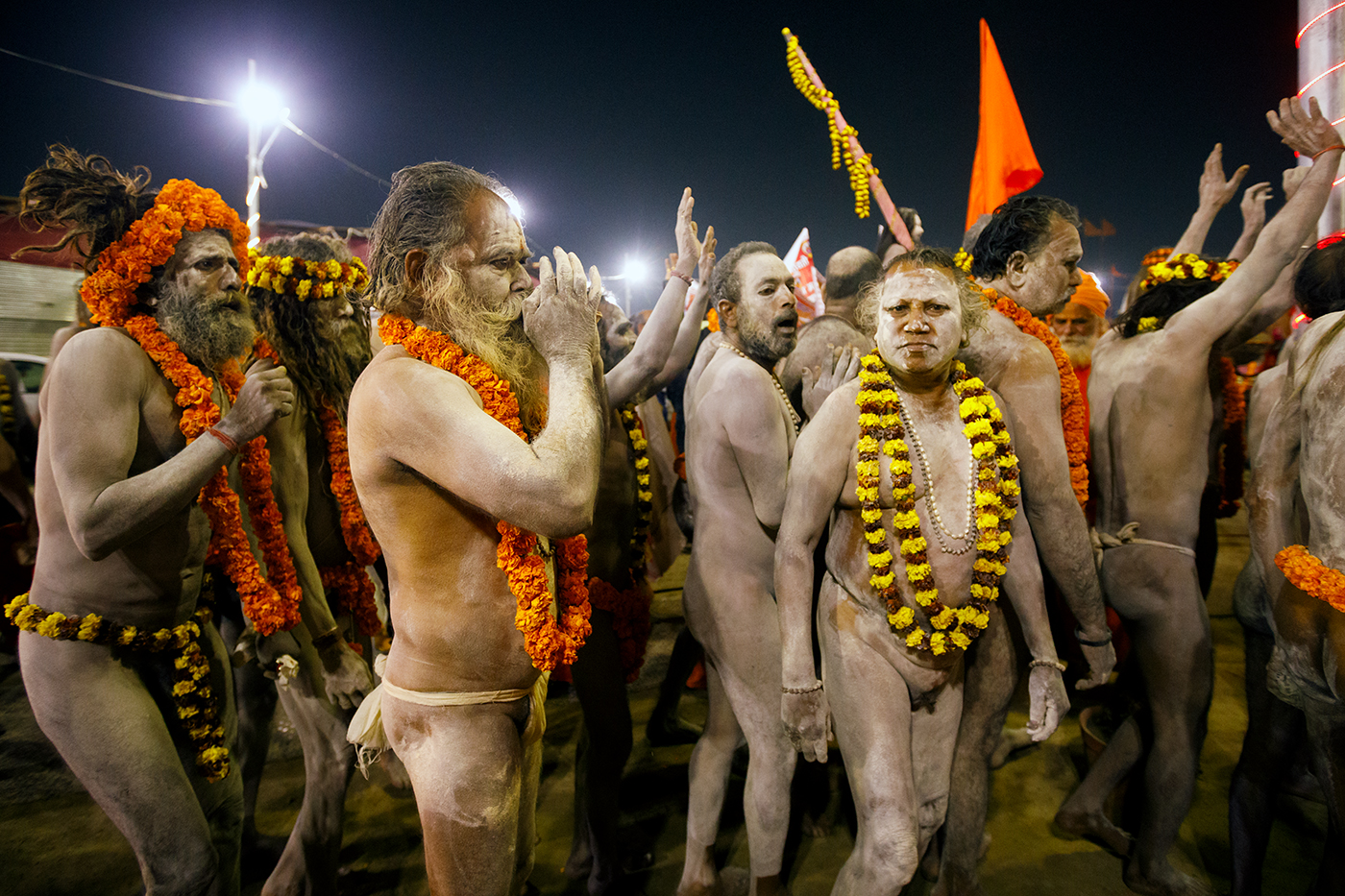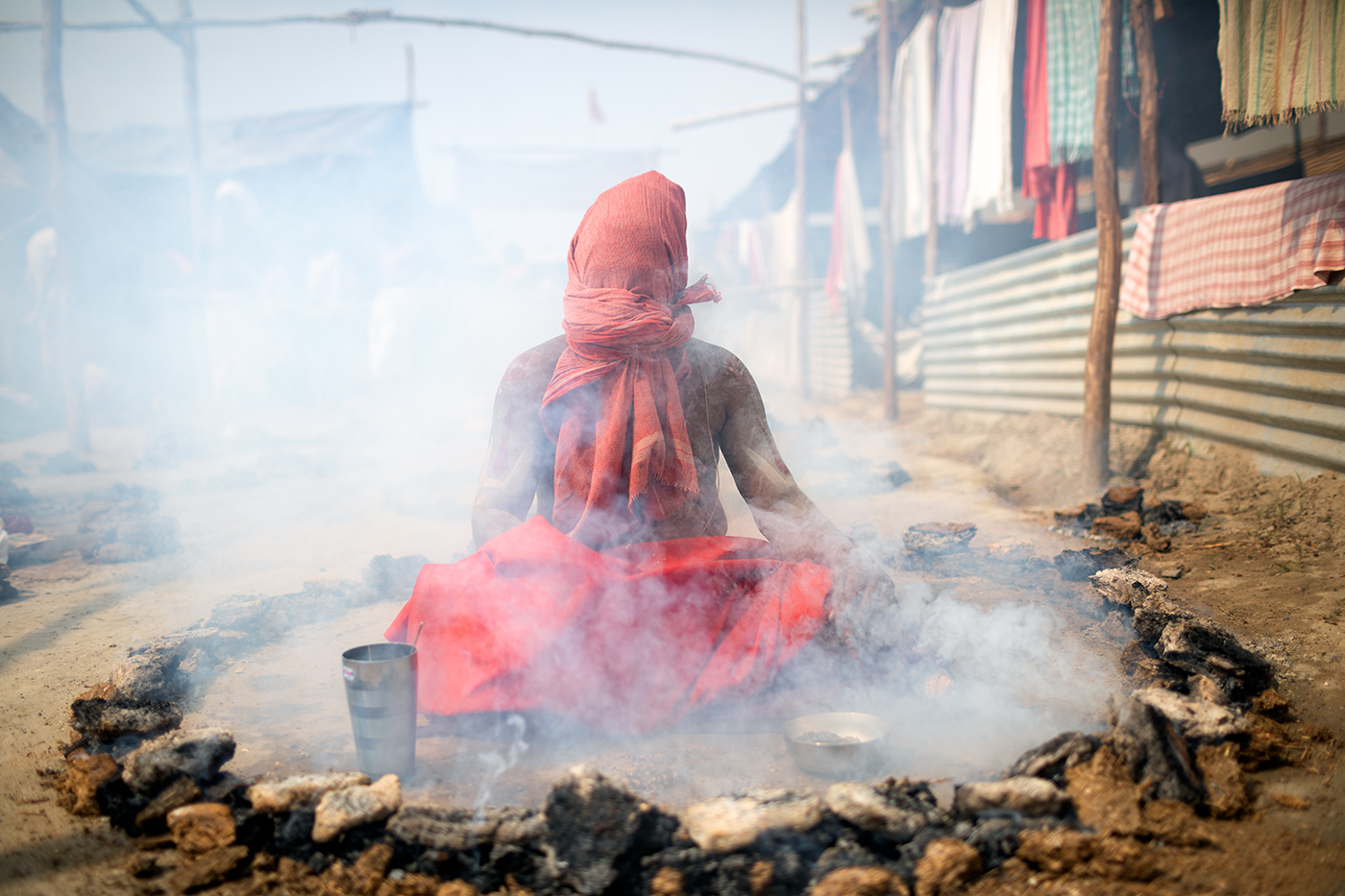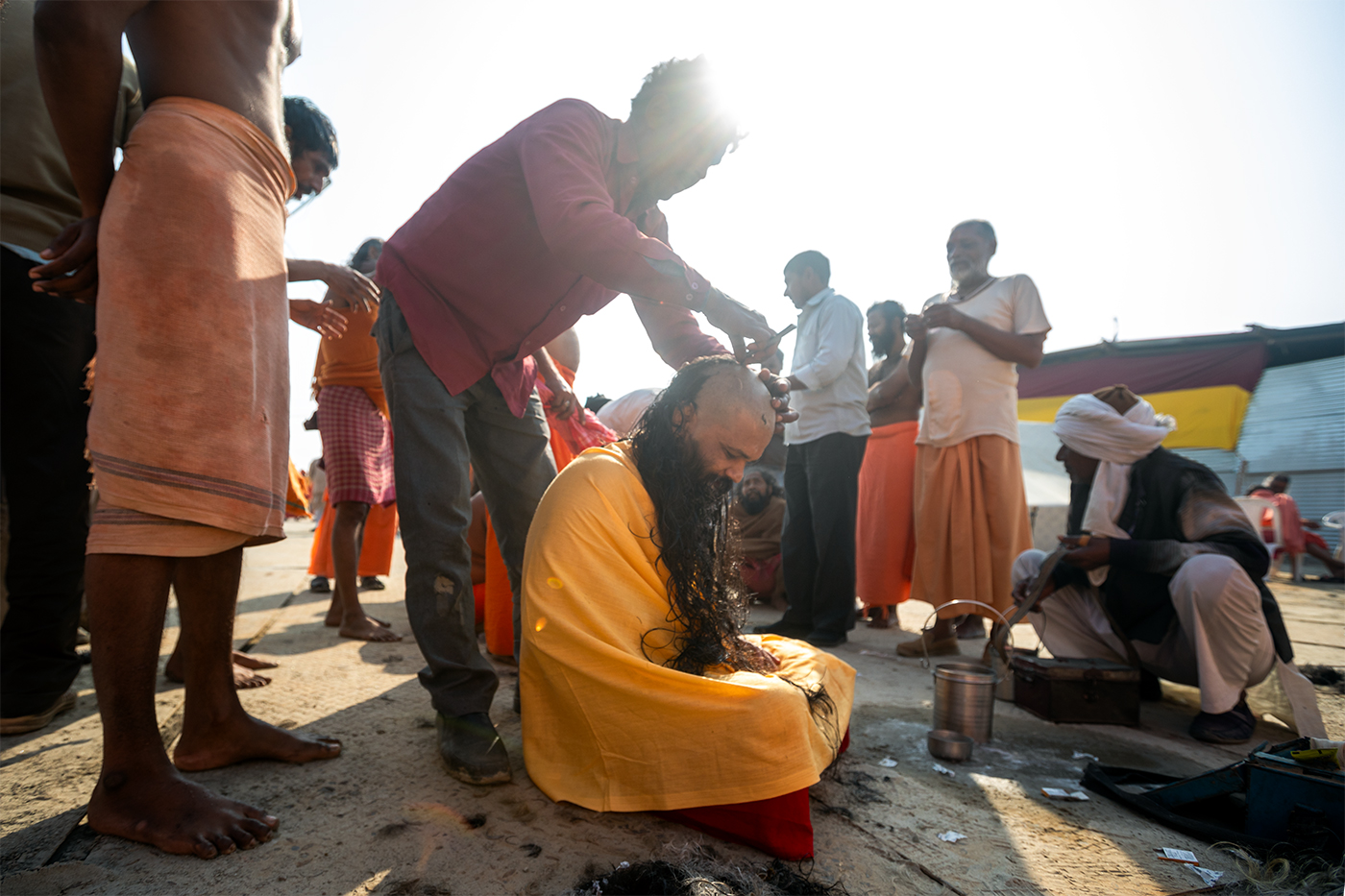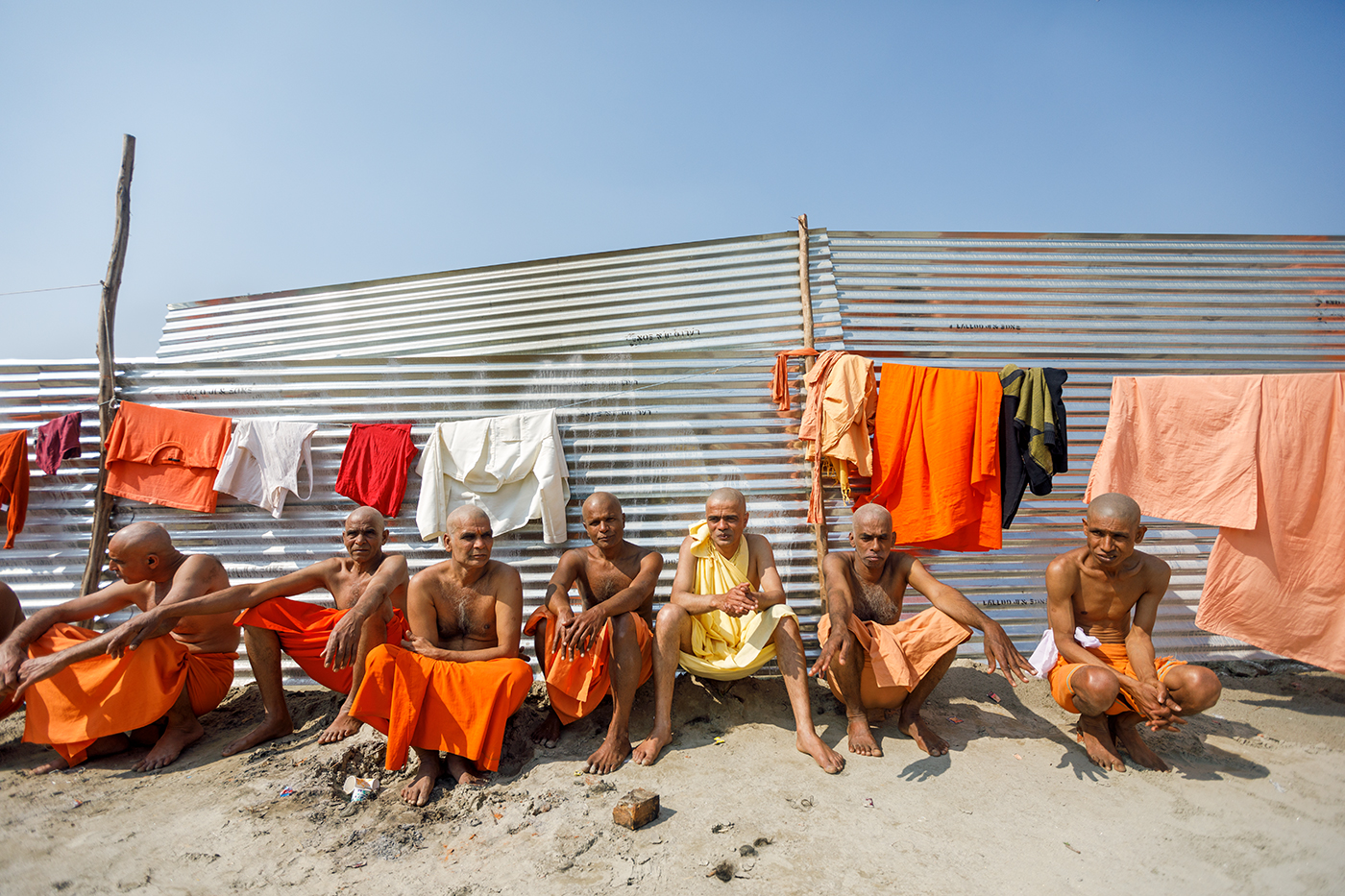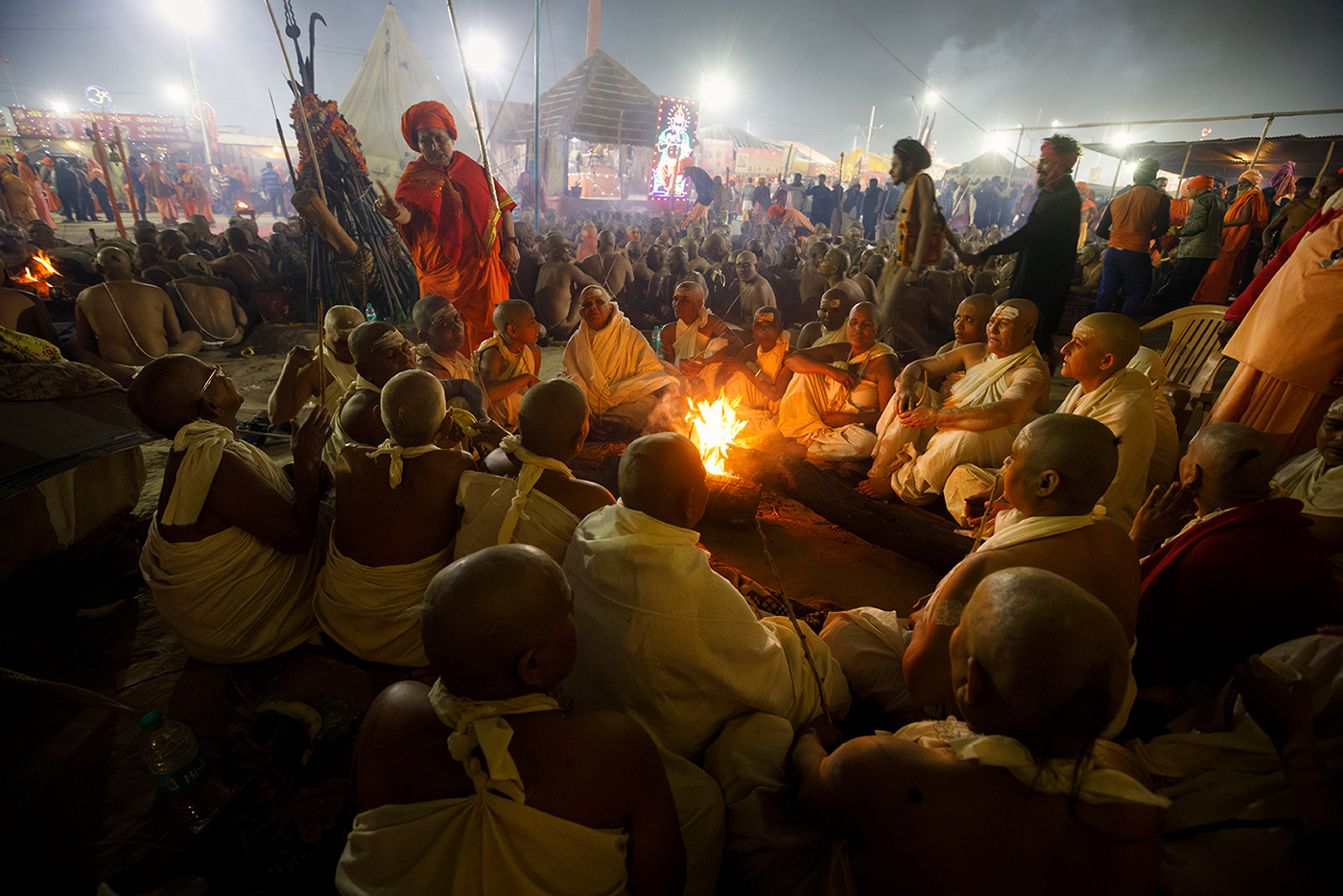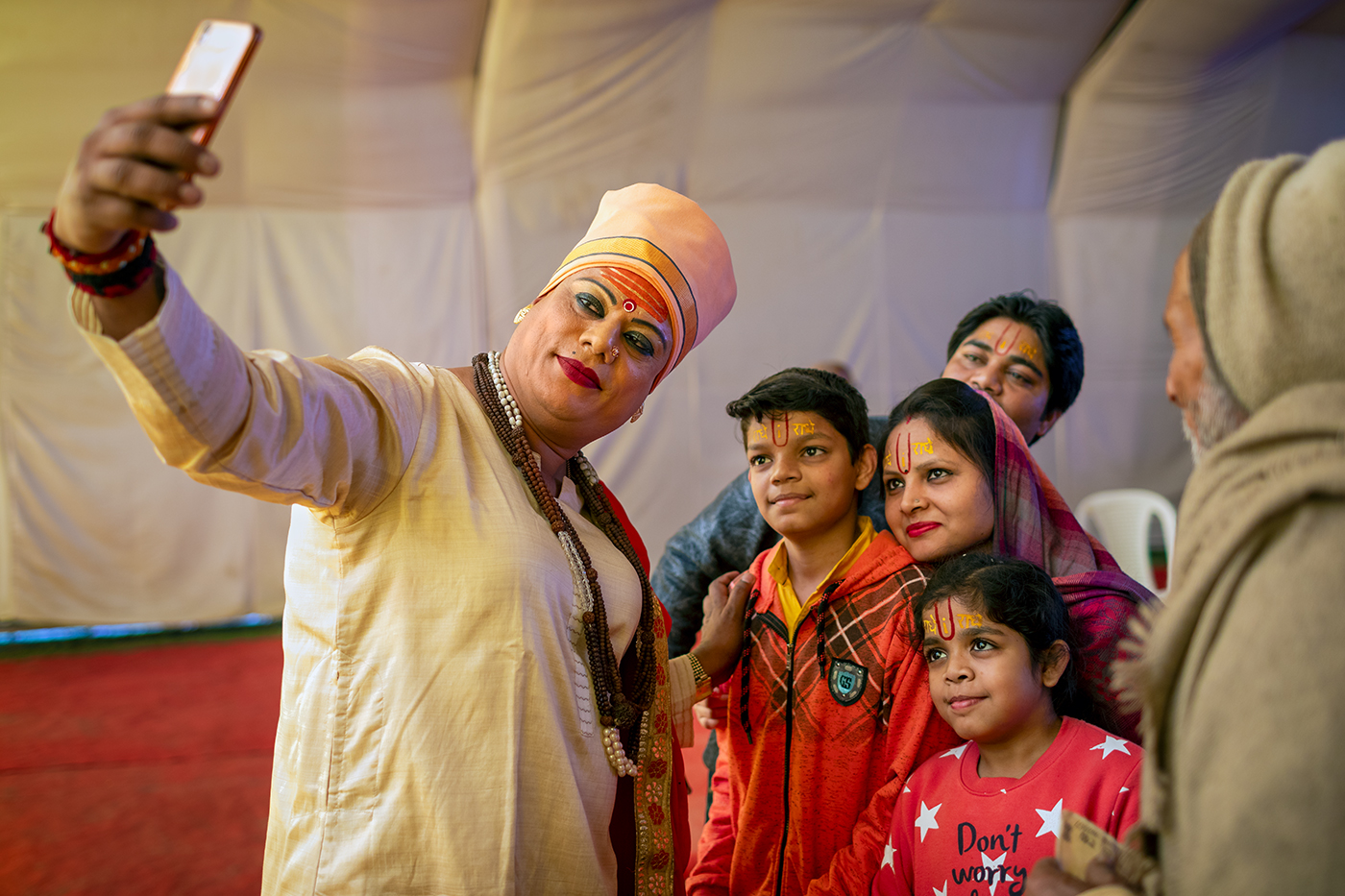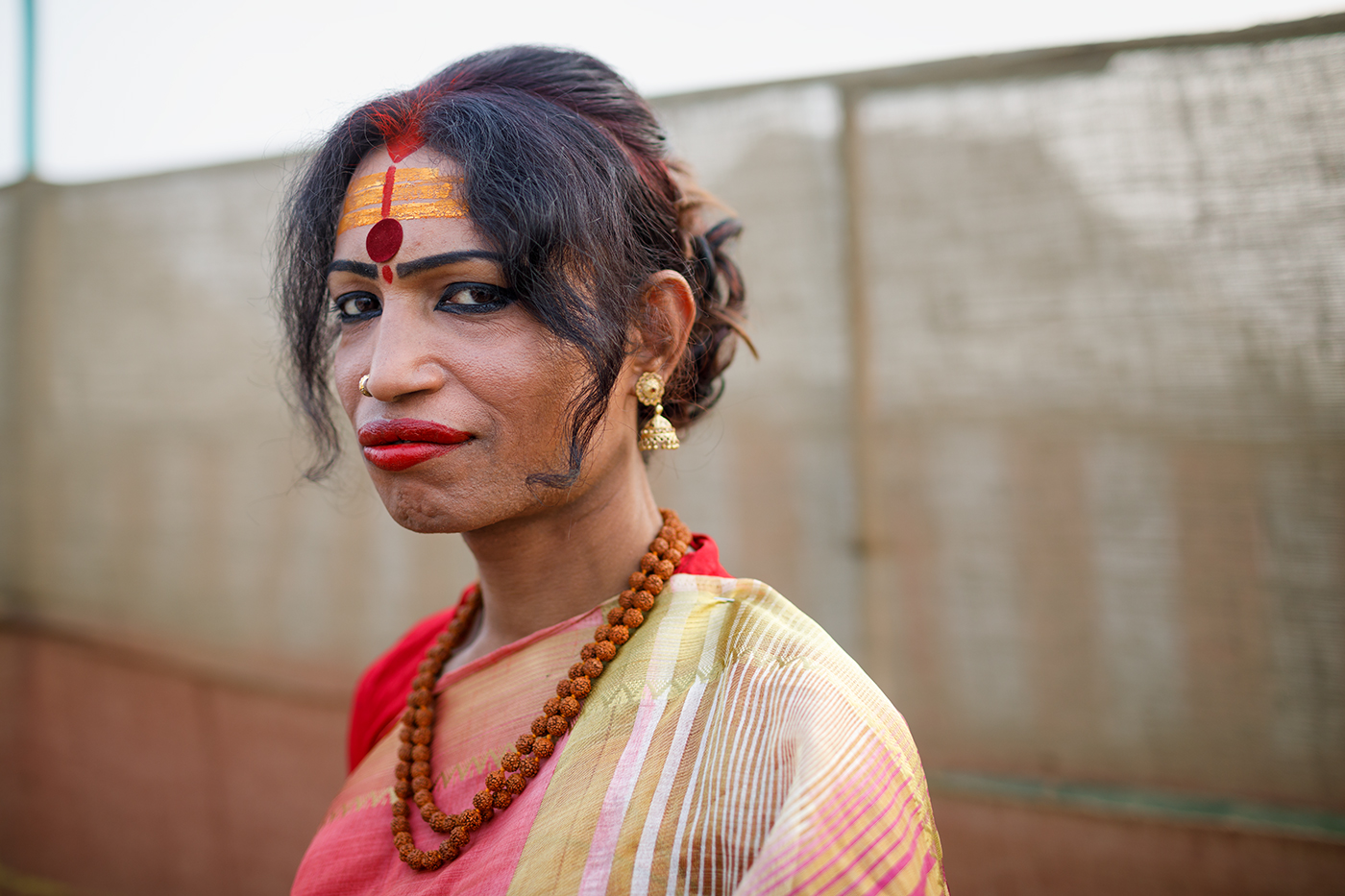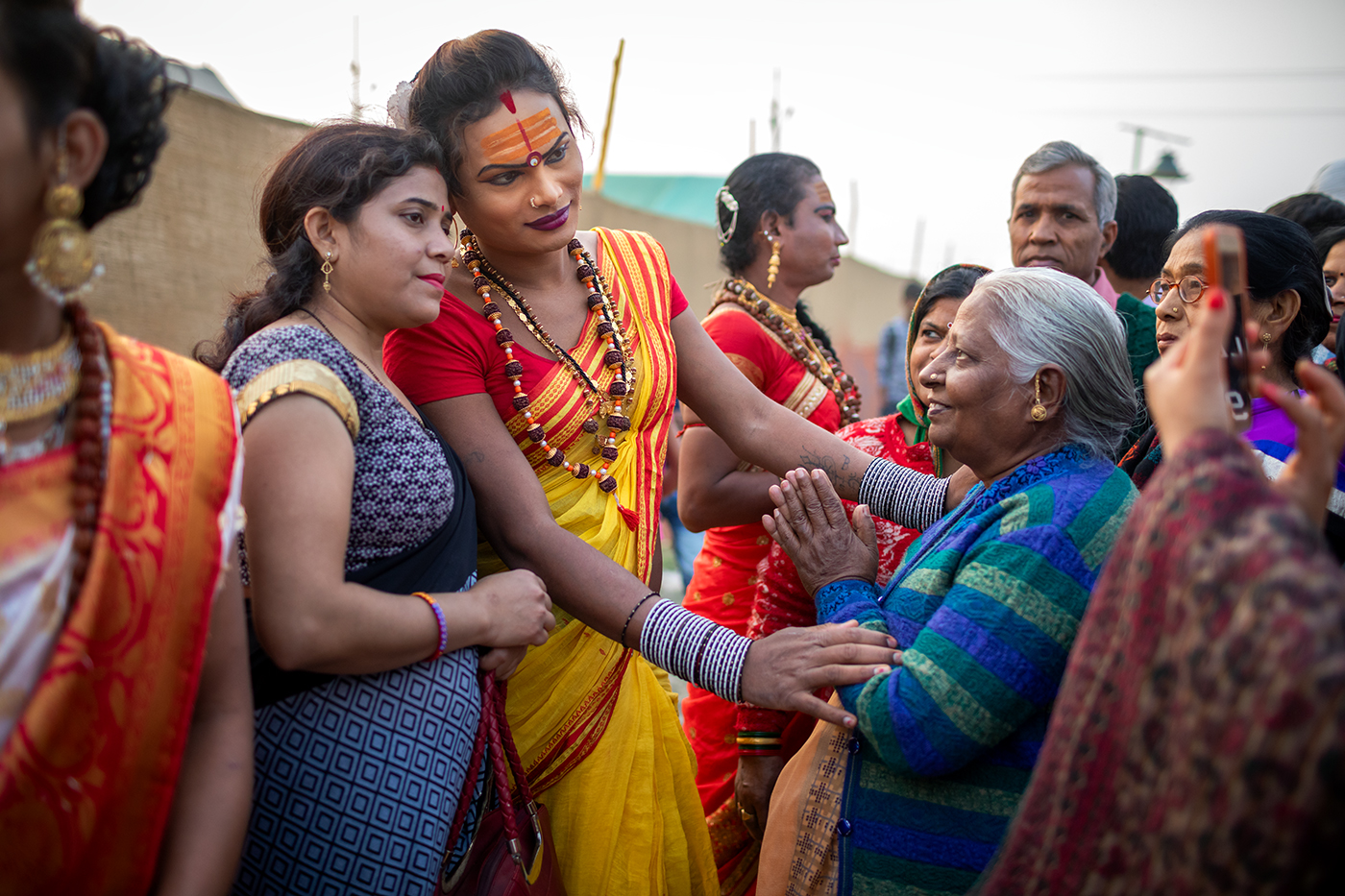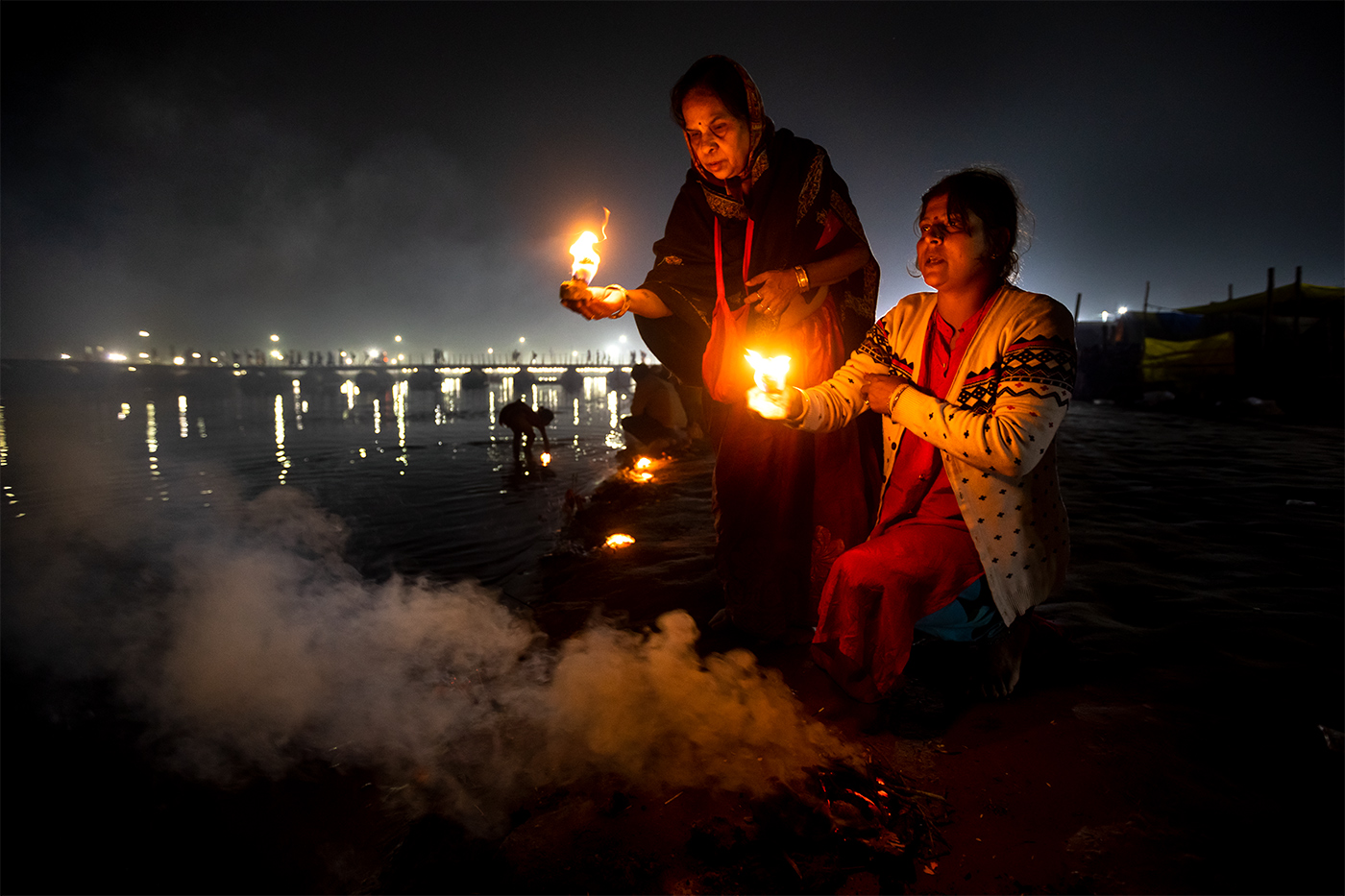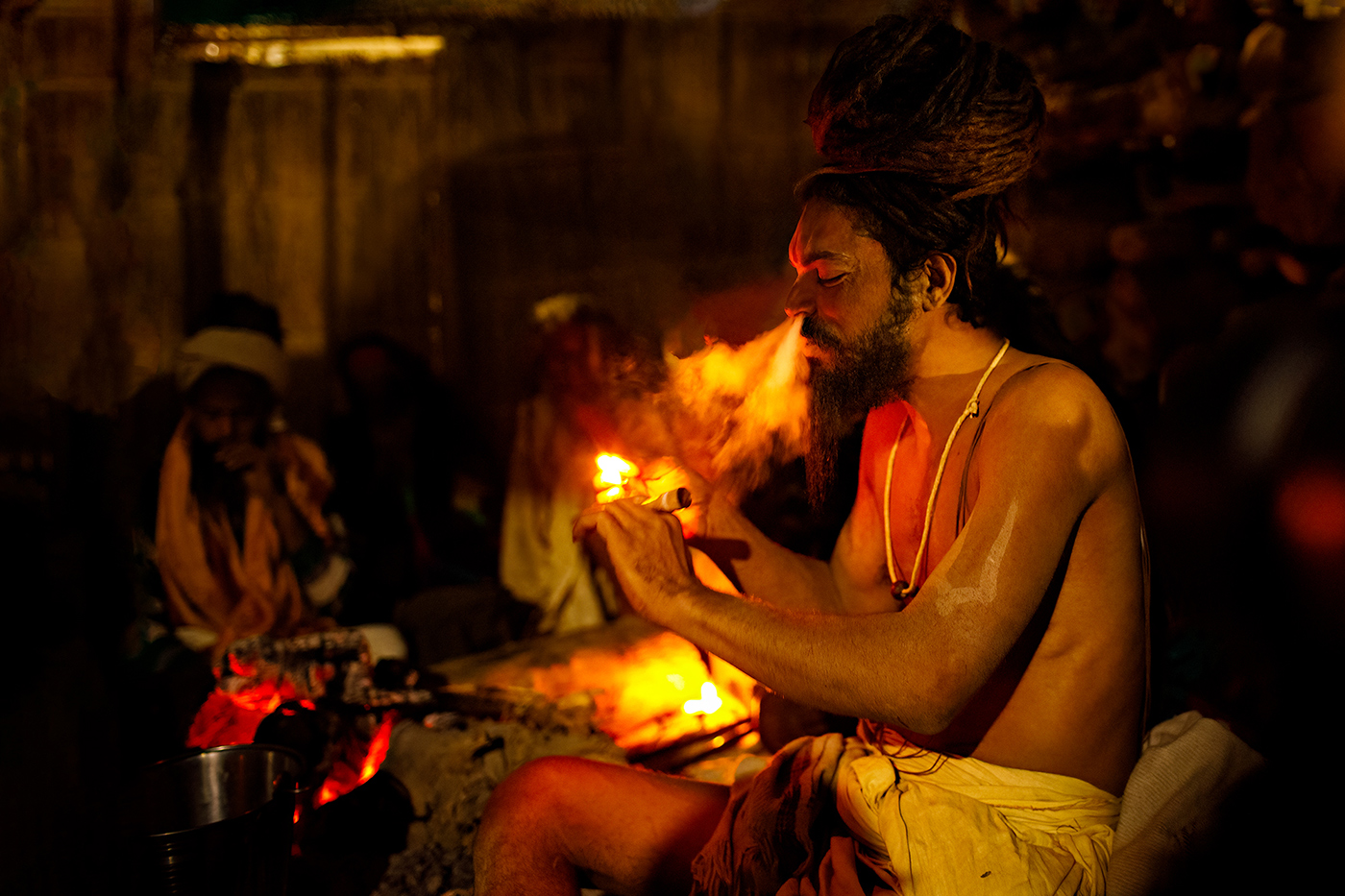As a photographer specifically focused on people and rituals, my journey through the lens has been a captivating odyssey over 38 years. Among the myriad events and festivals, I’ve had the privilege to document, as one would say, the profound testament to culture, spirituality, and human connection — the Kumbh Mela.
For the past 12 years, I have immersed myself in the vibrant chaos and serene moments of Kumbh Mela, the World’s largest religious gathering. From the tranquil banks of the sacred rivers to the bustling streets filled with devotees, each frame I capture narrates a story of faith, tradition, and diversity.
Understanding the mythology
The Kumbh Mela is not just an event; it represents a profound gathering of souls seeking spiritual rejuvenation. This sacred assembly, held at the banks of India’s holy rivers, brings together millions of pilgrims and ascetics from diverse walks of life and spiritual backgrounds. The palpable energy and devotion permeating the Kumbh Mela weave together a vibrant tapestry of cultural significance and religious fervour.
The origins of the Kumbh Mela can be traced back to ancient texts such as the Bhagavata Purana, which recounts the Samudramanthan episode. In this mythological tale, Devas (celestial beings) and Asuras (demons) united in churning the primordial ocean in search of the nectar of immortality, called amrita. This cosmic event culminated in the emergence of Dhanwantari, bearing the sacred Kumbh (pot) of amrita. Drops of amrita are believed to have fallen at four sacred locations: Allahabad (Prayag), Haridwar, Ujjain, and Nashik, sanctifying them as the sites for the four Kumbh Melas. Held every 12 years, the Maha Kumbh Mela is a spiritual and cultural pilgrimage, embodying unity, spirituality, and the eternal quest for inner awakening.
A Photographer’s Perspective – eventually it will come to you!
Capturing the essence of Kumbh Mela requires more than technical expertise; it demands a deep appreciation for humanity’s collective yearning for transcendence. My approach to photographing Kumbh Mela revolves around immersion and empathy. I endeavour to seamlessly blend into my surroundings, earning the trust of my participants, and capturing authentic moments of devotion, introspection, and celebration.
My first experience with Kumbh dates back to 2013. The initial three days presented a significant challenge. Despite carrying two cameras on my shoulder and being awake all the time, I struggled to capture a single image that resonated with the spiritual and cultural depth of the event. I found myself questioning my purpose, wondering if I had come solely to capture portraits when countless experiences were unravelling around me. This inner conflict plagued my nights, leaving me restless and consumed by doubt.
Millions stayed overnight under the open sky for a holy dip during the 2013 Kumbh Mela on the Ganges in Prayagraj.
The magnitude of this enormous event and the presence of millions of people overwhelmed me. It dawned upon me with great clarity: a profound responsibility rested on my shoulders to faithfully capture the true essence and aura of the Kumbh Mela through my photography. This internal dilemma was tremendously painful; it was not just about capturing moments but about capturing the soul of the Kumbh Mela.
On the fourth day, clarity dawned upon me like a divine revelation. My realisation hit me that I intended to depict the Kumbh Mela not solely as a modern event, but as an ancient tradition deeply rooted in history and spirituality. It was a turning point where my focus shifted from merely taking pictures to telling stories through my lens – stories that echo the timeless essence of Kumbh Mela and its rich heritage.
During a tragic accident at the 2013 Allahabad Kumbh Mela, I made this picture. It was estimated that in the Allahabad Kumbh Mela 2013, more than twenty-six thousand people have been lost, thousands have been injured, and more than a hundred were stampeded in this tragic accident. This image reminds me of the dangers and risks associated with large-scale events like the Kumbh Mela. The incident prompted calls for better crowd control measures and safety protocols to prevent similar tragedies in the future.
However, during the 2019 Prayagraj Kumbh Mela, the entire scenario went through a dramatic shift. I found myself in a high-tech setting. The integration of technology into this religious event brought a new level of convenience and efficiency to the experience. For example, with the help of GPS tracking, pilgrims could easily locate their designated campsites, while mobile apps provided real-time updates on events and schedules. Overall, the infusion of technology enhanced the overall experience of the Kumbh Mela for both the organizers and the attendees. In the process of the modernization of Kumbh Mela, sadhus are allowed a special pass for the holy dip.
Pontoon Bridges: An Iconic Symbol of Allahabad Kumbh Mela.
Pontoon bridges consist of a series of watertight concrete boxes assembled and secured to create a continuous structure. The top surface serves as a roadway for traffic. These bridges have been utilized since ancient times, with the Zhou Dynasty credited for creating the first pontoon bridge. Typically temporary, pontoon bridges are commonly deployed during wartime and civil emergencies.
In preparation for one of the world’s largest religious gatherings, extensive planning and hard work are required over several months. Authorities are anticipating that approximately 200 million visitors will gather for a holy dip at Sangam, the confluence of the Ganges, Yamuna, and mythical Saraswati Rivers during the 2025 Maha Kumbh Mela. The preparations include constructing at least 22 temporary pontoon bridges to accommodate the influx of pedestrians, vehicles, and animals expected to arrive on the riverbanks. Notably, in 2019, bridge number 19, the longest pontoon bridge in the history of the Kumbh, stretched 1.1 kilometres across the Ganga, connecting the Naini and Chatnag sides of the river. This bridge comprises 230 pontoons and is situated near Chatnag Ghat. Currently, over 1,800 floating steel pontoons are undergoing repairs, construction, or installation. Decking is being added as thousands of workers gear up for the event.
Naga Sadhus
I’m fortunate enough to be connected with many Naga Sadhus. Naga Sadhus are one of the main attractions of Kumbh Mela. They are a unique and revered sect of sadhus (ascetics) in India, known for their austere and unconventional lifestyle. They are often associated with the worship of Lord Shiva and are deeply immersed in spiritual practices.
Naga Sadhus stand out for their renunciation of worldly possessions, including clothing. They often wear sacred ash and Rudraksha beads which symbolize their deep devotion to Lord Shiva. Becoming a Naga Sadhu is no easy feat. It requires a demanding initiation and a lifelong commitment to discipline and letting go of material wants. These ascetic wanderers tirelessly strive for spiritual enlightenment.
Naga Sadhus are frequently encountered during major religious gatherings such as the Kumbh Mela and the Ardh Kumbh, where they play a significant role in the spiritual proceedings. They are known for their fearless and fierce demeanour, reflecting their detachment from worldly fears and desires. Deep in the mountains of the Himalayas, these sadhus live in subzero temperatures, wearing nothing more than a single piece of cloth and taking very minimal food.
As they are in search of enlightenment or ‘moksha’, they have extremely strict rules to follow as they need to conserve energy for their concentration and meditation. They consume a certain amount of ‘charas’ or ‘hash’, which exclusively grows only in the Himalayan mountains. This specific kind of ‘charas’, when consumed, produces an immense amount of heat in the body, so it helps them to cope with the extreme cold temperatures in the mountains.
Despite their ascetic lifestyle, Naga Sadhus are highly respected in Indian spiritual traditions for their wisdom, dedication to spiritual practices, and role as guardians of ancient spiritual knowledge. Their presence at these events serves as a reminder of the importance of renunciation and self-discipline in the pursuit of spiritual enlightenment. Many people seek their blessings and guidance, believing that their austere way of life holds the key to unlocking higher spiritual truths. Naga Sadhus are often sought out for their insights on meditation, yoga, and other spiritual practices. Their teachings are believed to offer a path to inner peace and enlightenment for those who are willing to learn from them. Their deep connection to nature and dedication to a life of simplicity also inspire others to reflect on their own spiritual journey and connection to the world around them. Many view Naga Sadhus as living embodiments of ancient wisdom, offering valuable lessons on the power of devotion and discipline in achieving spiritual growth.
A group of Naga Sadhus with ashes on their bodies after the Sahi Snan in the 2013 Allahabad Kumbh Mela.
The Sahi Snan, also known as the Royal Bath, is one of the most spectacular events of the Kumbh Mela, where all thirteen akharas participate according to a pre-fixed schedule.
During Sahi Snan, saints and their disciples, known as ascetics of the Akharas, bathe at the river on auspicious days and at specific times. The procession for Sahi Snan, or royal bathing, showcases the strength and grandeur of the Akharas. They move like armies, with disciples riding horses and elephants, hence the term ‘Shahi Snan.’ It is believed that taking a holy dip during this royal bathing at the Kumbh Mela leads to immortality.
The tradition of Sahi Snan dates back centuries, believed to have originated during the 14th–16th centuries. In ancient times, ascetics and saints in the Akharas were tasked with protecting Dharma, often wielding weapons. Since bathing in the Ganga is believed to wash away sins, these weapon-wielding ascetics and saints were given precedence for the Sahi Snan. This tradition continues to this day, with the Sahi Snan being considered the most significant ritual of the Kumbh Mela. Until the ascetics complete their bathing, devotees are not permitted to bathe on that day.
A Vaishnava Sadhu, who is a devotee of Lord Vishnu, is performing Dhuna Tapasya: Panch Agni Tapasya in Allahabad Kumbh Mela in 2019.
Sadhus practice a severe austerity called the panch-agni-tapasya, or five-fire practice. During this practice, the sadhu places pieces of burning cow dung around them as they meditate or perform hatha yoga. Over eighteen years, the sadhu progressively increases the number of fires from five initially to eventually forming a complete ring of fire, culminating in having a pot of burning cow dung atop his head by the end. This austerity is usually practised during the hottest point of summer, and it severely tests the sadhu’s ability to remain focused on their chosen mantra and deity. Sadhus sit in the ring of fire for at least five to twelve hours per day in seven stages.
Highlighting People and Rituals
One of the most rewarding aspects of my Kumbh Mela journey is documenting the diversity of rituals and practices. From the solemnity of early morning prayers to the exuberance of processions and rituals, every frame reflects a slice of the rich tapestry of Indian culture. The faces I encounter, weathered by time yet illuminated by faith, tell stories of resilience and devotion that transcend language barriers.
I made this image during a profound moment at the Allahabad Kumbh Mela 2019, where Sadhus of the Juna Akhara, the oldest and largest Akhara, were engaged in a mass initiation ceremony to become Naga Sadhus, also known as Naked Yogis. This initiation represents one of the most challenging periods in the life of a Sadhu. The process demands a complete transformation where they must relinquish their old identities, including their hair, and perform sacred rituals such as the Pind Daan for themselves and their living family members. They must perceive themselves as deceased to their families and society during this transition.
Becoming a Naga Sadhu also entails participating in intense night-long fire ceremonies, symbolizing a rebirth into the ancient order of Naga Sadhus. It is a deeply spiritual and physically demanding journey where the Sadhus must consider themselves dead to their families, and society and embrace a new spiritual existence.
Having witnessed this initiation ceremony firsthand, I have observed the raw emotions and pain experienced by the Sadhus. Many are brought to tears as they carry out these rituals, symbolizing the profound sacrifice and dedication required on their path. I recall a poignant moment when I approached one of the Naga Sadhus, asking why he was crying during the rituals. His response echoed the depth of their commitment and devotion: “My father is alive, but today, I performed his after-death rituals.”
This emotional exchange encapsulates the spiritual weight and sacrifices made by these ascetics, offering a glimpse into the profound spiritual journey undertaken by Naga Sadhus during the Kumbh Mela.
In the community of Naga Sadhus, both men and women are present. However, Naga Sadhvis, also called “Maata” (female Naga Sadhus) are rare and seldom interact with the world. Women become Naga Sadhus after rigorous penance. For this, they have to perform the same rigorous reparation for years, offer Pind Daan while they are still alive, shave their heads, and then go to a secluded place and become a female Naga Sadhu. Female Naga Sadhus live isolated lives in forests, caves, and mountains, dedicating themselves to the worship of God. Unlike male Naga Sadhus, female Naga Sadhus do not practice nudity; instead, they wear saffron-coloured clothes. The cloth worn by female Naga Sadhus is unstitched and is used to cover their bodies. Female Naga Sadhus are also known for their strict adherence to celibacy and ascetic practices, just like their male counterparts. Despite the challenges they face, these women continue to pursue spiritual enlightenment and dedicate their lives to serving a higher purpose.
Transgender Sadhus
Pavitra Nimbhorakar, a leader and secretary of the Kinnar Akhada, oversees the 2,500 members of the Hindu ascetic order during the Kumbh Mela. Pavitra has been with the group since its inception and said that they had been prepping to participate in Prayagraj Kumbh for two years.
In a historic first during the 2019 Kumbh Mela, a group of transgender sadhus, known as the Kinnar Akhada, made their debut. Led by transgender activist Laxmi Narayan Tripathi, a former reality TV star and prominent activist known for her distinctive tattoos, the group’s members adorn themselves in vibrant sarees and jewellery, making a striking appearance at the festival.
Traditionally, akhadas have been male-dominated, with no akhadas led by cisgender women and only a few women ascetic members in certain groups. However, the transgender religious order was embraced by the Juna Akhada, the oldest and largest of the 13 sects that establish camps at every Kumbh to conduct prayers, religious lectures, and blessings for visitors. Inclusion in the Juna Akhada granted transgender members the privilege to participate in the royal holy dip (shahi snan) on auspicious days at the confluence of rivers in Prayagraj, ahead of millions of other pilgrims.
Impact and Reflection
Through my photography, I aim not only to capture moments but also to preserve cultural heritage and foster cross-cultural understanding. Each photograph from Kumbh Mela carries a message of unity in diversity, reminding us of the shared human experience that transcends borders and beliefs. The impact of such documentation extends beyond mere visual storytelling; it becomes a bridge that connects hearts and minds across the globe. Amidst the chaos of a crowded festival, I’ve captured moments of connection and unity, highlighting the beauty and complexity of human expression and spirituality. As I continue to document the rich tapestry of human experience, I’m reminded of the common thread that binds us all together. Photography, to me, is not just an art form but a tool for building bridges and nurturing a sense of shared humanity. I hope that my images inspire others to see the world through a more compassionate and inclusive lens.
In conclusion, my journey as a photographer at Kumbh Mela has been transformative, deepening my appreciation for the intricacies of human expression and spirituality. I strive to highlight the beauty and complexity of different traditions by sparking conversations and promoting empathy. Ultimately, I believe that photography has the power to break down barriers and bring people closer together in a world that is often divided by differences.
I invite you to explore my gallery, which showcases moments from Kumbh Mela, where every click of the shutter echoes centuries of tradition and the timeless quest for divine communion. Thank you for joining me on this photographic pilgrimage through the sacred waters of Kumbh Mela.
Embark on a photographic journey of a lifetime with the Maha Kumbh Mela Photo Tour 2025. Don’t miss this rare opportunity to capture the grandeur of the world’s largest religious assembly through your lens. Join me for this once-in-a-lifetime experience and immerse yourself in photographing the awe-inspiring moments of the ‘Maha Kumbh Mela Photo Tour 2025’.


